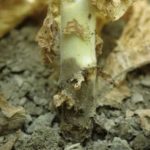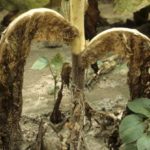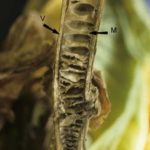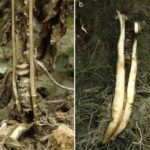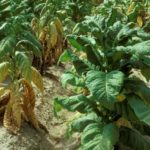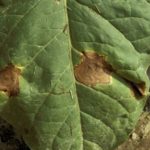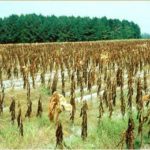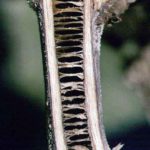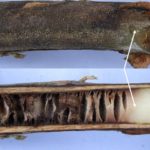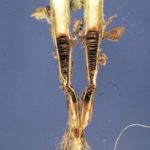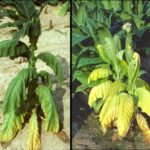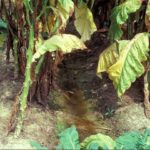.
Condición fitosanitaria: Presente
Grupo de cultivos: Industriales
Especie hospedante: Tabaco (Nicotiana tabacum L.)
Rango de hospedantes: amplio / no específico
Etiología: Pseudohongo. Necrotrófico
Agente causal: Phytophthora nicotianae Breda de Haan (1896)
Taxonomía: Eukaryota > Stramenopiles > Oomycetes > Peronosporales > Phytophthora
.
.
.
Antecedentes
Phytophthora nicotianae es un pseudohongo con capacidad de supervivencia en el suelo, que causa una de las enfermedades más destructivas del tabaco. Ocurre principalmente en climas cálidos y húmedos de las regiones ecuatoriales y tropicales. Es particularmente grave en los EE. UU., en muchos países de América Central, Brasil y Sudáfrica. En estos países es común ver campos completamente destruidos por el patógeno. Es una enfermedad grave en muchos otros países también. Phytophthora nicotianae a veces se observa en climas templados. Los cultivos de tabaco en varios países europeos sufren pérdidas a causa de esta enfermedad. Causa pérdidas en Grecia, mientras que en otros países europeos como España, Italia, Alemania y Bulgaria solo causa daños menores.
.
Sintomatología
.
- Autor: D Blancard (INRA)
- Autor: D Blancard (INRA)
- Autor: D Blancard (INRA)
- Autor: D Blancard (INRA)
- Autor: Gallup et al., 2006
- Autor: Gallup et al., 2006
- Autor: Gallup et al., 2006
- Autor: Gallup et al., 2006
- Autor: Gallup et al., 2006
- Autor: Gallup et al., 2006
- Autor: Gallup et al., 2006
- Autor: Gallup et al., 2006
- Autor: Gallup et al., 2006
- Autor: Gallup et al., 2006
.
.
.
Bibliografía
Avila-Quezada GD, Rai M (2023) Novel nanotechnological approaches for managing Phytophthora diseases of plants. Trends Plant Sci.: S1360-1385(23)00102-4. doi: 10.1016/j.tplants.2023.03.022
Brasier C, Scanu B, Cooke D, Jung T (2022) Phytophthora: an ancient, historic, biologically and structurally cohesive and evolutionarily successful generic concept in need of preservation. IMA Fungus 13(1): 12. doi: 10.1186/s43008-022-00097-z
Gallup CA, Sullivan MJ, Shew HD (2006) Black Shank of Tobacco. The Plant Health Instructor. doi: 10.1094/PHI-I-2006-0717-01
Hunter S, Williams N, McDougal R, et al. (2018) Evidence for rapid adaptive evolution of tolerance to chemical treatments in Phytophthora species and its practical implications. PLoS One 13(12): e0208961. doi: 10.1371/journal.pone.0208961
Kato F, Ando Y, Tanaka A, et al. (2022) Synthesis of aglycones, structure-activity relationships, and mode of action of lycosides as inhibitors of the asexual reproduction of Phytophthora. Biosci Biotechnol Biochem. : zbac179. doi: 10.1093/bbb/zbac179
Kronmiller BA, Feau N, Shen D, et al. (2023) Comparative Genomic Analysis of 31 Phytophthora Genomes Reveals Genome Plasticity and Horizontal Gene Transfer. Mol Plant Microbe Interact. 36(1): 26-46. doi: 10.1094/MPMI-06-22-0133-R
Lin X, Torres Ascurra YC, Fillianti H, et al. (2023) Recognition of Pep-13/25 MAMPs of Phytophthora localizes to an RLK locus in Solanum microdontum. Front Plant Sci. 13: 1037030. doi: 10.3389/fpls.2022.1037030
Liu Y, Sun M, Jiang Z, et al. (2022) Screening of tobacco genotypes for Phytophthora nicotianae resistance. J Vis Exp. (182). doi: 10.3791/63054
Liu Y, He P, He P, et al. (2022) Potential biocontrol efficiency of Trichoderma species against oomycete pathogens. Front Microbiol. 13: 974024. doi: 10.3389/fmicb.2022.974024
Miller TG, Richmond M, Vann M, Hansen Z (2023) Sensitivity of Phytophthora nicotianae in Tennessee and North Carolina to mefenoxam, oxathiapiprolin, mandipropamid, and fluopicolide. Plant Dis. doi: 10.1094/PDIS-04-23-0632-RE
Neupane K, Ghimire B, Baysal-Gurel F (2022) Efficacy and Timing of Application of Fungicides, Biofungicides, Host-Plant Defense Inducers, and Fertilizer to Control Phytophthora Root Rot of Flowering Dogwoods in Simulated Flooding Conditions in Container Production. Plant Disease. doi: 10.1094/PDIS-02-22-0437-RE
Situ J, Xi P, Lin L, et al. (2022) Signal and regulatory mechanisms involved in spore development of Phytophthora and Peronophythora. Front Microbiol. 13: 984672. doi: 10.3389/fmicb.2022.984672
Song R, Tan Y, Ahmed W, (2022) Unraveling the expression of differentially expressed proteins and enzymatic activity in response to Phytophthora nicotianae across different flue-cured tobacco cultivars. BMC Microbiol. 22(1): 112. doi: 10.1186/s12866-022-02531-z
Sun M, Li L, Wang C, et al. (2022) Naringenin confers defence against Phytophthora nicotianae through antimicrobial activity and induction of pathogen resistance in tobacco. Mol Plant Pathol. doi: 10.1111/mpp.13255
Wang W, Zhang J, Cao Y, et al. (2022) NtbHLH49, a jasmonate-regulated transcription factor, negatively regulates tobacco responses to Phytophthora nicotianae. Front Plant Sci. 13: 1073856. doi: 10.3389/fpls.2022.1073856
